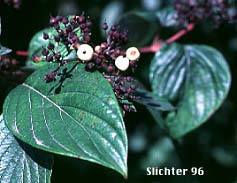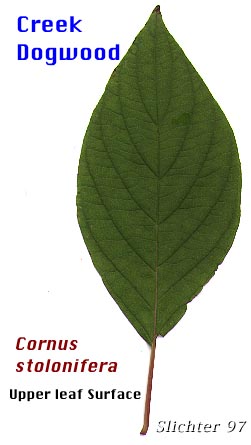 Photo at right shows the whitish
berries of Cornus sericea.
Photo at right shows the whitish
berries of Cornus sericea.
Characteristics:
Creek dogwood is an attractive, multi-steemed shrub from 2-6 meters tall. The younger twigs are bright red to reddish-purple and gray-green on older twigs. The twigs commonly root upon contacting moist soil. The leaves are oval, dark shiny green above, and lighter below (See leaves below.). The leaves are 4-12 cm long and prominently veined. The leaves appear opposite on the twigs, and have entire margins.
The flowers are in flat-topped cymes, with the flower heads lacking the large white bracts of its cousins. The white petals are small, from 2-4 mm long. Plants may flower both in spring as well as in the fall. The berries are white.
Wet forest sites, frequently along streams, in ditches, or in wetland swales.
Creek dogwood is found over much of North America.
In the Columbia River Gorge, it is found between the elevations of 100'-3100' west of the mouth of the Deshutes River.
1. Ornamental shrub.
2. Wood is strong, used for tool handles.
3. Small straight stems, once called dags (hence the original plant name- dagwood), which are used as skewers for campfire cooking.
4. The bark was at one time dried and used as a tea for treating colds & flu.
5. The inner bark was once used in tobacco mixtures and for tanning or drying animal hides.
6. The white, sour berries were occasionally eaten.
7. Wildlife browse the twigs, leaves and beries.


Creek dogwood blooming at a seep on basalt road cuts along the old haul road between Klickitat, WA and the small community of Suburbia, Klickitat River Canyon........April 29, 2022.